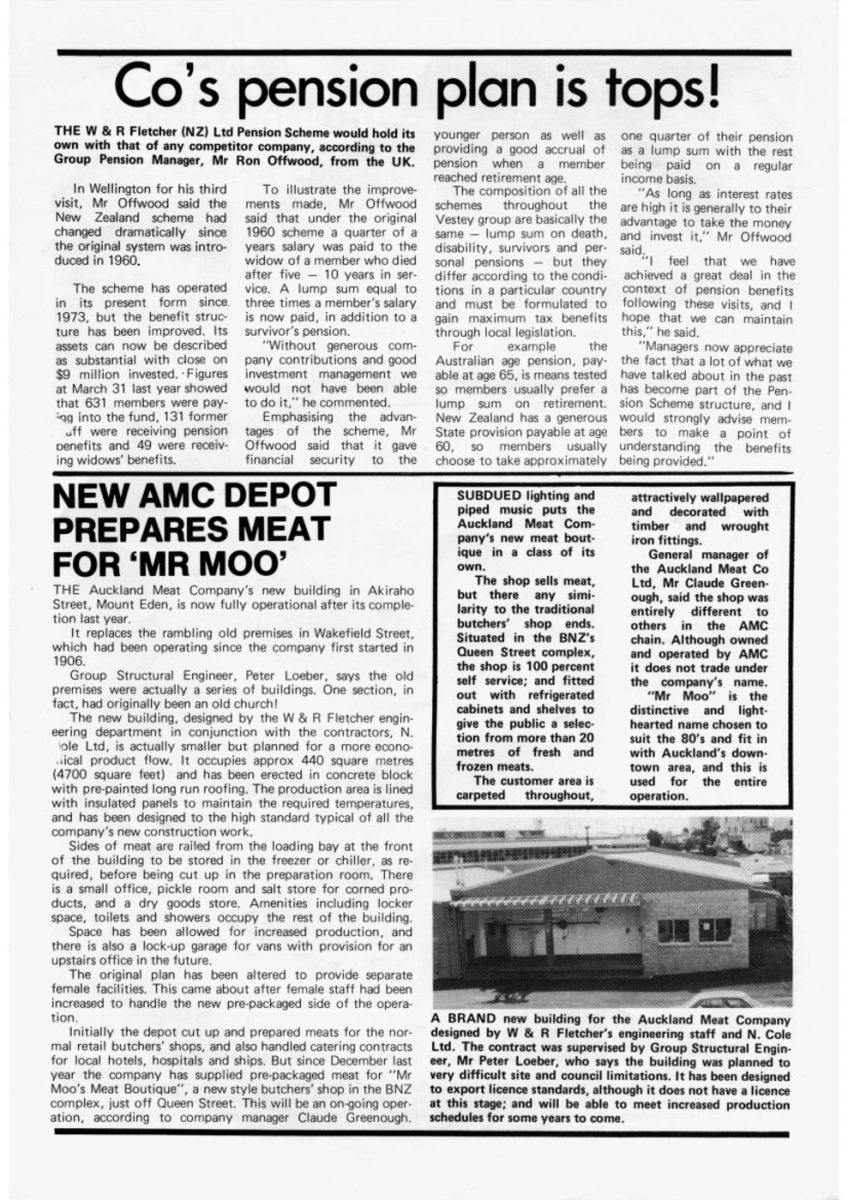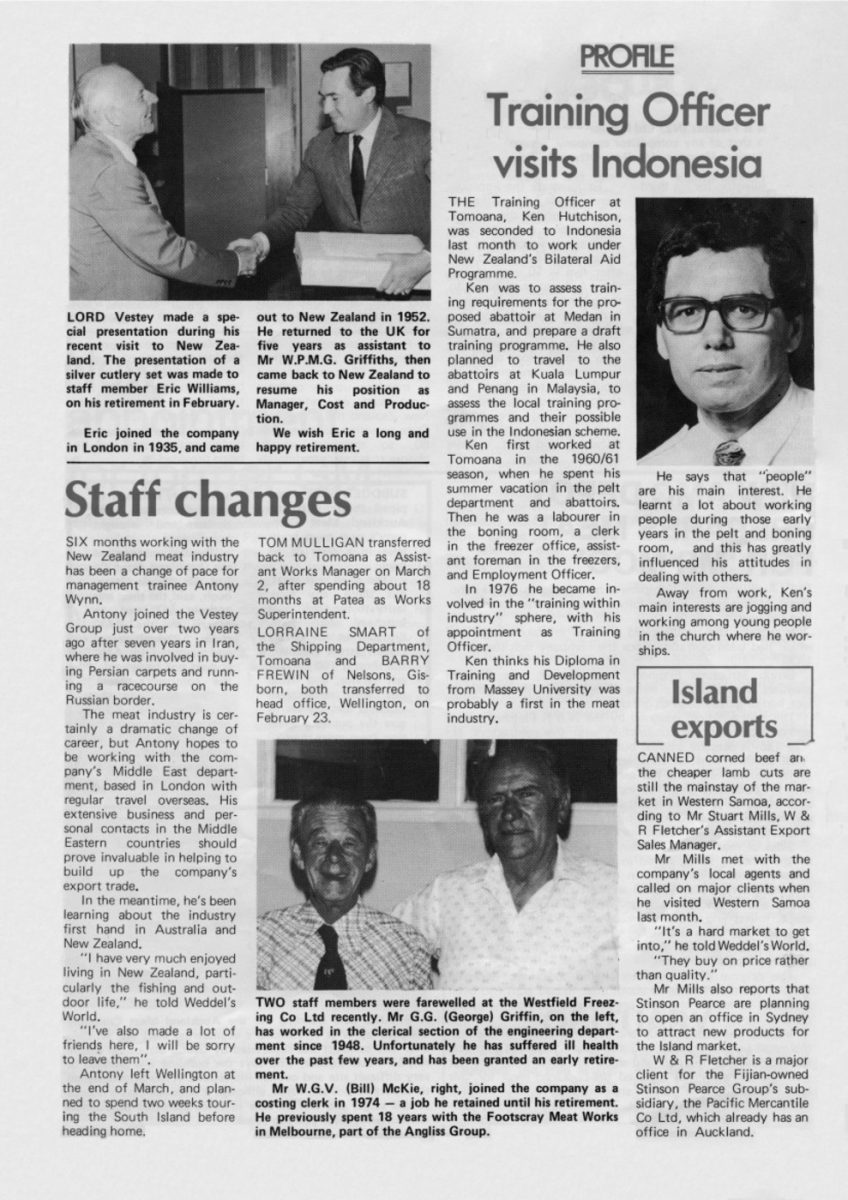Further leather sales predicted in the East
LEATHER is big business in Japan, Korea and other Eastern countries. Many different types of hides and skins are imported for conversion into leather, for a variety of uses. These include hides and skins from cattle, calf, buffalo, horse, goat, pig, deer, kangaroo, crocodile, lizard, frog – even eel.
W & R Fletcher’s By-Products Manager, Mr H. J. Beauchamp, is confident that the company can extend its export of hides into these areas, especially Japan.
During a recent tour of existing and developing markets in the East, Mr Beauchamp met with agents and buyers to discuss the range of products available and confirm quality and supplies.
Japan is a very important market, particularly for wet, salted hides. For the statistical year ending June 1980, Japan absorbed approximately 35 percent of the company’s total salted exports. Since then, W & R Fletcher has continued to sell large quantities of hides to Japan; and the 1980/81 statistics are expected to show further increases.
Japan in fact imports more than 8.5 million cattle hides each year including approximately 80 percent from USA, 13 percent from Australia and 5 percent from New Zealand.
Mr Beauchamp reports good sales for Weddel branch light cow hides, and says he hopes to see an increase in the sale of other ranges, such as calf skins.
Strong market “We already have a very strong hide market with Japan,” he added. “But there is still room to strengthen our position.”
The lighter cow ranges which form the bulk of imports to Japan are intended primarily for gloving and other clothing, such as leather jackets. New Zealand cow hides, and particularly the “spready” types from the dairy areas, are considered to be one of the best sources of raw material for making high quality garment leather.
Korea, one of the developing markets, is more interested in the heavier ranges such as bull, ox, and heavy cow – the type of leathers which go into industrial footwear and combat boots, baseball gloves and the heavier motorcycle jackets.
Lighter leathers
Mr Beauchamp forecasts a gradual extension into lighter clothing leathers, but says Korea will have to compete against Japan for the available raw materials.
Little expansion is expected in Hong Kong, where the emphasis is on the cheapest possible leathers-splits for industrial gloves, and cheap grains for the tourist and souvenir market. New Zealand’s quality is far too good for this market.
But moves are being made to sell more hides into the People’s Republic of China through Hong Kong associates.
“There is good potential there but it will probably take some time to develop,” Mr Beauchamp says.
Short supply
Hides are in fairly short supply worldwide due to stock retrenchments, and it will probably be two or three years before the situation improves. Availability could also be affected if there is any sudden improvement in demand from Europe (Italy has always been one of our major customers).
Another consideration in the availability of wet salted hides is the increasing production of wet blue hides in this country. Some interest is coming from Korea and the People’s Republic of China, but Japan is not able to consider this material at present due to quota restrictions and high import duties.
“All Eastern countries are potentially big customers for New Zealand and will continue to show an interest in our products,” Mr Beauchamp added. “Availability and price will be the major factors.”
New appointment for former GM
FORMER Group General Manager of W& R Fletcher, Mr Mark Hinchliff, has been appointed for a three year term as Chairman of the New Zealand Fishing Industry Board.
Interviewed shortly after the official announcement, Mr Hinchliff said he didn’t feel there was any contradiction in leading the fishing industry after a long time in the meat business.
“Meat and fish are not dissimilar in export terms,” he commented. “Fish, like meat, is perishable and seasonal creating associated problems. While the fishing industry is dealing with similar markets, it is also looking for new export markets in such areas as the Middle East, Spain and West Africa.
“The board is conscious of the fact that it represents a diverse and competitive industry. It has commercial fishermen, share fishermen, joint venture programmes, foreign licensed vessels and seafood processors and exporters to satisfy.
“We have now established a fish export industry of some magnitude worth nearly $160 million per annum, which has become a very important earner for New Zealand. However, we must be most careful not to over-fish – taking up more than is being reproduced.”
The other important consideration, which he again relates to the meat industry, is quality of presentation. “Quality must be improved to attract and maintain customers,” he says. Mr Hinchliff has worked and travelled in many countries during more than 46 years with the meat industry, and thinks that his administrative and commercial experience must have had a bearing on the appointment.
“I am highly honoured that the Government should appoint me, and believe it reflects credit on the Vestey organisation for the early training and opportunities provided,” he told Weddel’s World.
OBITUARY
W & R FLETCHER management and staff extend deep sympathy to the colleagues and families of David Heynes, NZFCA; Ian Cairney, MAF, and Alan Baldry, of the British High Commission, who were killed in a road accident on May 7, 1981.















Do you know something about this record?
Please note we cannot verify the accuracy of any information posted by the community.